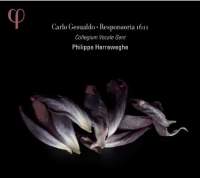Texte paru dans: / Appeared in:

Fanfare Magazine: 37:4 (03-04/2014)
Pour
s'abonner / Subscription information
Les abonnés à Fanfare Magazine ont accès aux archives du
magazine sur internet.
Subscribers to Fanfare Magazine have access to the archives of the magazine
on the net.
PHI
LPH010

Code-barres / Barcode : 5400439000100 (ID369)
Synchronicity strikes again. Here, on the heels of Marco Longhini’s beautifully boxed set of Gesualdo’s secular madrigals (see my review above), is a release of the composer’s sacred music. As annotator Glenn Watkins puts it in the booklet, Gesualdo’s sacred music fell completely into oblivion. Watkins surmises that part of this may have been due to the fact that very few copies have survived, indicating (to him) that the print run may have been very small to begin with. Yet there may also be the barrier to non-religious listeners who simply do not respond to this type of music. As always, it depends on the quality of the music and the quality of the performances.
Watkins’s liner notes do not indicate whether or not the published copies of these scores call for the number of voices used here, which range between 13 and 19. (Herreweghe’s choir includes six female singers.) Nevertheless, the group is splendid. It has that rare combination of good vocal blend, transparency of texture and excellent diction that made Longhini’s madrigal performances equally exceptional. Moreover, as Longhini’s high male voices blended perfectly with the lower ones, so do Herreweghe’s female voices blend perfectly with the male, including four countertenors (two designated as “altus” and two as “quintus”) with equally exceptional voices.
What Watkins does indicate, however, is that the religious music is not as harmonically daring as the last two books of madrigals: “the moderation of their most extreme harmonic language in the sacred works cannot fail to be noted. Yet while the insistent contrast between fast (diatonic) and slow (chromatic) music found in the madrigals is less obvious here, the sacred texts offer abundant images for an inflected musical response.” In addition, as the performances unfolded, I heard quite a bit here that was considerably more advanced than any other liturgical music of its time; and, more to the point, not only the music but its performance here was considerably more emotional and powerful than the Gregorian chant and/or Palestrina music used at that time. Again, to quote Watkins, “Gesualdo’s introduction of such a powerful musical language into the ritual of Holy Week has been debated as a potentially disturbing contravention of the rules of post-Tridentine liturgical practice….We need only consider Gesualdo’s setting of Tristis est anima mea from the Maundy Thursday cycle to note the difference….The flight at the beginning is flurried and quickly cut off by a rhythmic snap; the offering of his soul and body that follows is embraced by one of the most affective and passionately chromatic passages in the entire cycle….In the Holy Saturday cycle, Aestimatus sum … is drama of a high order and of a kind rarely attained in the world of sacred music before or after.”
Watkins’s dry but accurate
description of this music says as much as I could, thus I will allow his
words to stand for mine here. From whatever viewpoint you approach this
remarkable set of discs, however, it is a gem to be cherished.
Fermer la fenêtre/Close window
Cliquez l'un ou l'autre
bouton pour découvrir bien d'autres critiques de CD
Click either button for many other reviews


